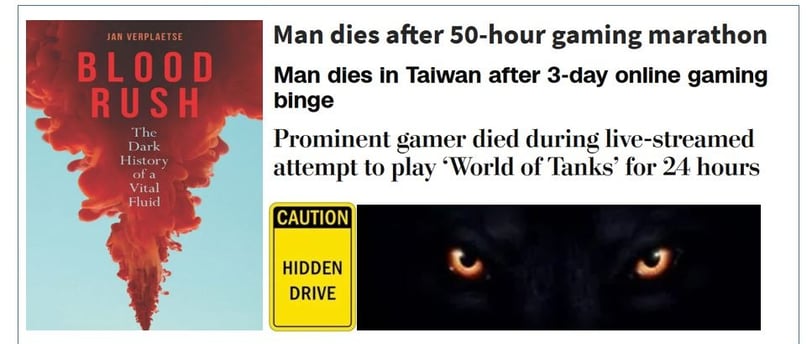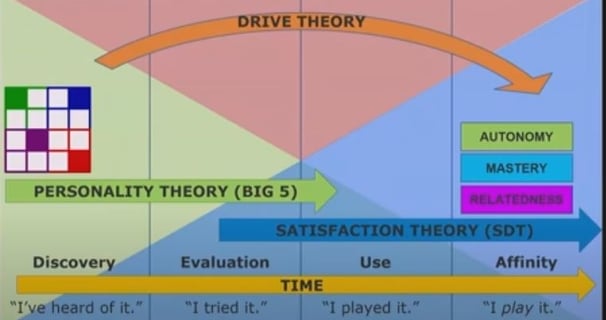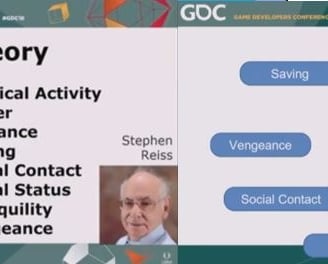CREATIVE LEARNING EXPERIENCES THAT CHANGE BEHAVIOR
The “Dark” Side of Drives that Drive Learner Engagement
Our drives drive engagement, even the “dark” ones.
LEARNER ENGAGEMENT
5/28/20253 min read


The 50 hour gamer stopped playing only to nip into the bathroom or to take short naps. He also left his job, apparently. Quit to play more games.
The 3-day guy was 32. He was a regular at that particular internet café, and would often play for days at a time. When tired, he would simply sleep face-down at the table.
The Twitch streamer was only 35.
Obviously it’s terrible that gamers died because of their excessive gaming. But this level of participant engagement is something an educator can only dream about. And video game designers are the Olympians of engagement - unlike most learning experience designers.
I wanted to start smothering the learning experiences I was creating with liberal lashings of this secret sauce (just without the participant literal-death part). So I embarked on a quest. (Fitting, no?) And discovered Jason VandenBerghe and The Drives. No, not an indie band (although it really should be). VandenBerghe is a longtime game designer, and one of his talks given at the Game Developer’s Conference sparked more than a few aha moments. In Drives: Helping More Players Get from First-Taste to Satisfaction, VandenBerghe maps out how players go from interested enough in a game to try it, to ending up motivated to keep playing.
The hook em’ part at the beginning can be explained by appealing to their personality traits as codified by 4 of the Big 5 Personality traits.
And the part that gives all personality traits long-term satisfaction is explained by self-determination theory. Everyone, regardless of personality trait, all wants the same things: to feel more competent, to have autonomy, and to experience relatedness.
But the rub is getting from the initial hook ‘em to long-term satisfaction. This piece is where our hidden human drives do the heavy lifting.
Drives like curiosity, honor and family – and the other 13 listed by Stephen Reiss are quite socially acceptable, but VandenBerghe makes the point that this list leans a little too far to the sunny side of the street.
Where’s vengeance? Addiction? Blood lust?
Unfortunately, the state of research on taboo topics like blood lust is as primitive as the drive itself, so I had to look to literature. In BLOOD RUSH: The Dark History of a Vital Fluid (Reaktion Books Ltd, 2020), Jan Verplaetse describes his own case of blood lust. It was triggered when he was a young college student. He went down to his parents’ cellar, where he was met by the main dish of the upcoming Christmas meal: the skinned carcass of a hare hanging upside down.
He writes:
"The most surprising thing was that I felt absolutely no fear, revulsion or disgust. On the contrary, I wanted to touch it. To stick my finger into the dish and stir it. To put my finger to my mouth and taste it. I wanted to smell it, feel it and savour it. Like a prehistoric cave painter, I wanted to draw figures on the white walls of the cellar with my red fingers. I felt excited and intoxicated. But above all, I experienced an endless fascination for this red bodily fluid that dripped from the hare’s throat and formed a red puddle. Suddenly, I understood why blood has had such a seductive attraction for humankind throughout the centuries."
Verplaetse concludes that blood lust is a holdover from our more (overtly) superstitious days. The role of blood in countless spiritual ceremonies attests to belief in its supernatural qualities. “Blood does not bring you into contact with your lower animal instincts, but with the powerful realm of immortal spirits and occult life forces.” It's also part of us that is wild. That has escaped being sanitized by modernity and tamed by civilization.
"The pleasure that comes from contact with blood meant that the aggression was enjoyable. Sadism helped with survival. Just as sexual lust encourages reproduction, bloodlust urges the attack of hostile animals and humans. Something we would not do spontaneously, because blood revolts us or because we are afraid of being injured or killed, is made easier by bloodlust.”
Blood lust was vital for our survival, but Verplaetse observes that it comes at a price: an instinct to cause harm. Pain. Death. "Bloodlust belongs to the darker side of humankind.”
Once upon a time, anyone?
Fairytales, in particular, tap into the dark side and provide a safe outlet for vicariously acting on our more questionable drives. But these drives, even the dark ones, help get the participants of games and learning experiences over that hump that kills most learning experiences to motivation, where engagement happens.
Making them, arguably, one of the most powerful tools in your learning designer’s arsenal.



